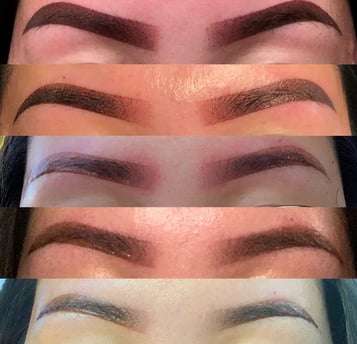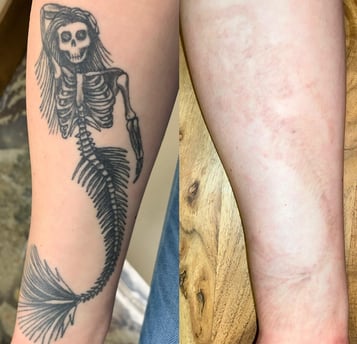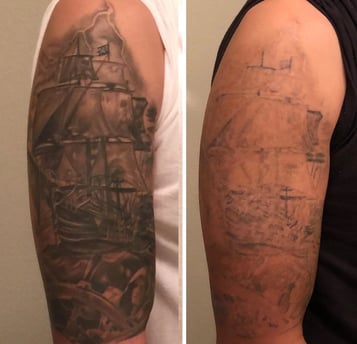Tattoo, Microblading and Micropigmentation removal
Techniques and methods to remove tattoo, microblading and micropigmentation removal
Dr Tushar Patial
2/15/20253 min read


The Various Methods of Tattoo Removal: A Comprehensive Guide
Tattoos are a popular form of self-expression, but sometimes, people may wish to remove them due to personal, professional, or aesthetic reasons. Fortunately, modern medicine and technology offer several methods for tattoo removal, each with varying levels of effectiveness depending on the type of tattoo, ink composition, depth, and skin type. In this article, we will explore the different techniques used to remove tattoos, including microblading and micropigmentation.
Why Consult an Expert Plastic Surgeon?
When considering tattoo removal, it is crucial to consult an expert plastic surgeon. A plastic surgeon has specialized training in skin healing, minimizing scarring, and achieving optimal cosmetic outcomes. They can assess the tattoo, skin type, and individual needs to recommend the best removal method while ensuring patient safety and comfort. An expert plastic surgeon can also handle complex cases, such as deeply embedded ink, large tattoos, and emergency removals, with the highest level of precision and care.
1. Laser Tattoo Removal
a. Q-Switched Laser
Q-switched lasers are one of the most common and effective methods of tattoo removal. They work by delivering high-intensity pulses of light that break down the ink particles in the skin, allowing the body’s immune system to gradually remove them. This method is highly effective for black and darker-colored tattoos but may require multiple sessions.
b. Alexandrite Laser
The Alexandrite laser is particularly effective for removing green and blue pigments, which are often difficult to treat with other lasers. It operates at a wavelength of 755 nm and is most effective on lighter skin tones. Like the Q-switched laser, multiple treatments are usually required.
2. Dermabrasion
Dermabrasion is a mechanical method that involves exfoliating the skin using a high-speed rotary device with an abrasive wheel or brush. This removes the upper layers of skin along with the tattoo ink. Although it can be effective, dermabrasion can be painful, requires significant healing time, and may lead to scarring.
3. Skin Grafting
For cases where a tattoo is deeply embedded or resistant to other removal methods, skin grafting may be an option. This involves surgically removing the tattooed skin and replacing it with a skin graft taken from another part of the body. This is an invasive procedure with a longer recovery period and a risk of scarring.
4. Saline Tattoo Removal
Saline removal is often used for cosmetic tattoos, microblading, and micropigmentation. A saline solution is tattooed into the skin to break up the pigment and encourage its removal through the body’s natural healing process.
Emergency Tattoo Removal with Saline
Saline removal can also be used for emergency tattoo removal if performed as soon as possible after tattooing. If someone regrets their tattoo immediately or has a bad reaction, a saline solution can be applied to draw out the ink before it fully sets into the skin. This method works best within the first 48 hours after tattoo application and should be done under the guidance of a skilled plastic surgeon to prevent scarring and infection.
5. Chemical Tattoo Removal
Certain chemical solutions, such as trichloroacetic acid (TCA), can be applied to the skin to peel away layers and remove tattoo pigment. While effective, this method can be painful and has a high risk of scarring, making it a less popular option compared to laser removal.
Choosing the Right Tattoo Removal Method
The choice of tattoo removal method depends on several factors, including:
The color and depth of the tattoo
The size of the tattoo
The skin type and sensitivity
The availability of professional treatments
The risk of scarring or side effects
An expert plastic surgeon is the best professional to consult for tattoo removal, as they can assess these factors and recommend the safest and most effective approach. Laser removal remains the gold standard for most tattoos, but other options like saline removal and dermabrasion may be more suitable for cosmetic tattoos like microblading.
Conclusion
Tattoo removal has come a long way with advancements in technology. Whether you want to remove a traditional tattoo or lighten microblading, there are multiple options available. However, patience is key, as most methods require multiple sessions and a proper aftercare regimen to achieve optimal results.
If you're considering tattoo removal, consult with an expert plastic surgeon to discuss the best method for your specific needs. With the right approach, you can safely and effectively remove unwanted tattoos and achieve clear, healthy skin.






